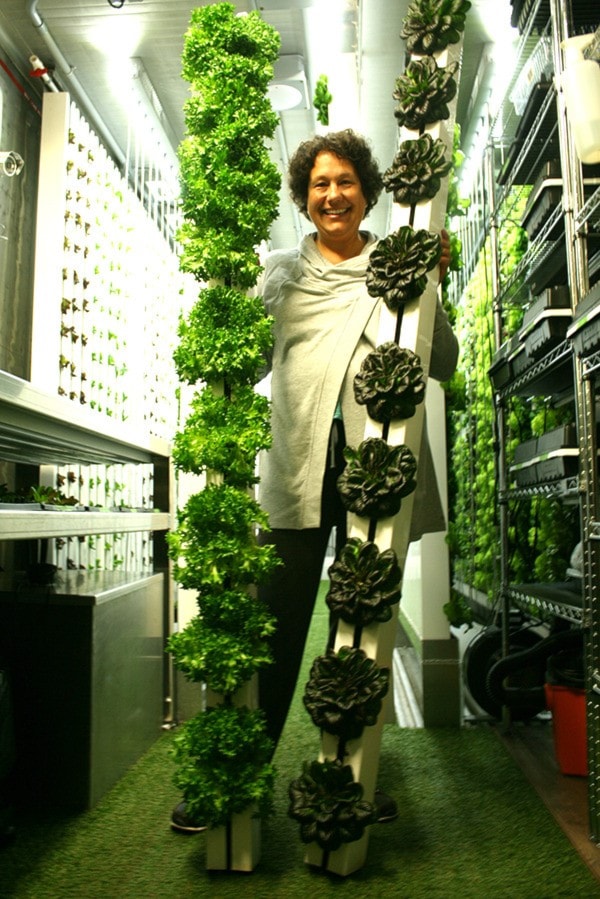The future of farming might be found inside the 40 x 8 x 9.5 feet dimensions of the Leafy Green Machine.
Those are the dimensions of a refurbished shipping container that stands on an agricultural lot in the 6000 block of West Saanich Road.
From the outside, the green-and-metallic box underwhelms. Step inside it though and you enter a world that evokes the agricultural wizardry of Matt Damon’s character in The Martian.
Tamara and Bruce Knott, who own the container, burst out in approving laughter when they hear this comparison.
“Except,” says Tamara, “he was growing those potatoes with a particular type of material with which we have nothing to do. I keep my vegans very happy.”
Differences in fertilizers aside, the Knotts also grow different crops, mainly lettuce as of now. Yet even the most cursory survey of the container underscores the technological sophistication of the Knotts’ business.
“Yeah, we are kind of nerds,” says Tamara.
Developed by the Boston-based company Freight Farms, the container houses an automated lighting and irrigation system that can roughly produce the yield of 1.5 acres of farmland.
Its heart consists of 256 vertically suspended cuboids (rectangular prisms). Each of these narrow “towers”, as the Knotts call them, can hold anywhere between 14 to 17 heads of various types of salad greens.
Each head begins life as a granular seed planted inside what Bruce calls a “peat plug” about the size of a pinky finger.
After growing in horizontally placed trays that receive a steady supply of nutrient-enhanced water, the plants are then planted several inches apart in the towers, each lined with a growing medium completely free of dirt and of a texture that Bruce compares to a “coarse brush.”
The towers are then hung between two horizontal metal cuboids.
The upper supplies each of the towers and the produce within them with nutrient-enriched water; the lower catches the run-off and sends it back into the irrigation system, where sensors continuously monitor the nutrient content, ph level and temperature of the water running through the system to ensure optimal growth.
“We don’t discharge any of that [water],” says Bruce. “We use it all. It just continues [to circulate through the system] and we just keep adding water at a rate of about five gallons a day, as the plants use it.”
This volume of water use marks a drastically reduced rate. “In terms of a conventional farming operation for these types of crops, the estimate is that the water use is 90 per cent less,” says Tamara.
Narrow ropes of energy-efficient LED lights, which Bruce says “look a little bit like disco lights,” add to the futuristic atmosphere.
Cascading off the container’s ceiling like party streamers, they emit blue and red light following a specialized schedule that ensures the plants receive optimal energy and rest. “For photosynthesis, plants predominately use light in the red and the blue spectrum, so we just give them that, because that is what they need to thrive,” says Tamara.
“They actually reflect the yellow and green back at our eyes, because they are not using it for photosynthesis.”
Aside from using far less water than outdoor farming, this type of indoor farming also foregoes pesticides and herbicides and requires far less land.
“You can put this unit on almost two parking spots downtown ... and you can feed a lot of people,” he says.
Finally, it can provide fresh produce year-around.
As such, it offers itself as a solution to a future marked by water shortages, declining supplies of arable land and growing urban populations facing various food security issues.
“The water, the lack of waste, the proximity to the people who are actually going to consume the food — we like all those things,” says Bruce. “That is why we sort of thought, this is the way of the future and we just want to be part of that future.”
With 85 million discarded sea containers available, others may follow the Knotts’ example.
If so, foodies might be in for a treat as well.
The Knotts, who describe themselves as “salad snobs,” say they “are pretty pleased with the quality of products.”
After spending three to four months to get their operation off the ground, the Knotts have been on the market for about a month now, selling to three local restaurants and customers at the local farmers’ markets. The Knotts are also organizing a network of pick-up points across Greater Victoria, where customers can pick up prepaid weekly produce baskets. “So folks are able to get their fresh produce, particularly at a time of year when none of the farmers’ markets are operating,” says Tamara.
So how do people react when the Knotts tell them where their lettuce comes from?
“Mostly, they say, ‘Cool! You can do that?’” says Tamara. “It has been really positively received and people are really excited about it. They think it is just a really, really neat idea.”
